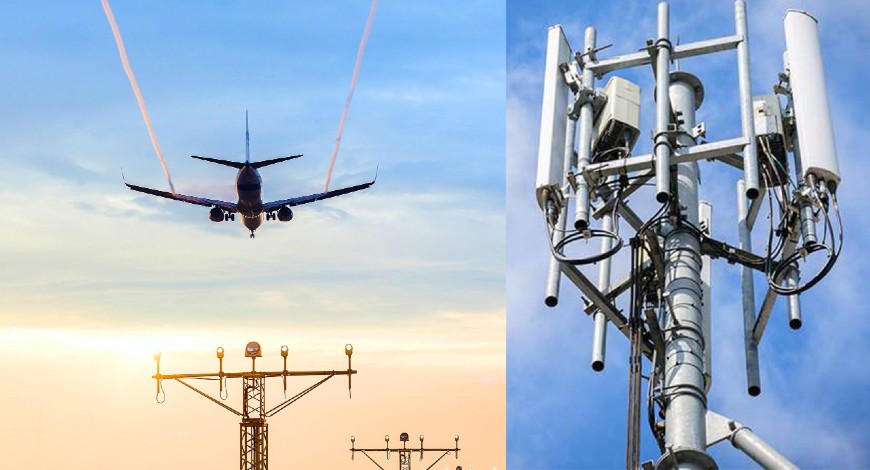5G
5G cell service, how it affects you, planes and diplomacy

The Federal Aviation Administration has named 50 U.S. airports, including New York, Los Angeles, Chicago, Las Vegas, Dallas, Philadelphia, Seattle, and Miami, that will be used as “buffer zones” when wireless carriers roll out their 5G C-Band services on Jan. 19.
AT&T and Verizon agreed last week to delay the rollout of 5G, the next-generation wireless technology, near the airports over concerns the technology could interfere with aircraft safety systems.
The wireless service launch was supposed to take place on Jan. 5, but aviation groups raised concerns and the Department of Transportation requested that the deployment be postponed.
The 5G technology has implications for airlines, but it already has an impact on your cellphones and also on relationships between some of the most powerful countries in the world.
Here’s what you should know:
What is 5G and how is it different?
Just like 3G and 4G, the latest wireless service operates on the same radio frequencies that are currently being used for your smartphone, on Wi-Fi networks, and in satellite communications. But what sets it apart is it enables technology to go a lot further, according to Ericsson.com.
Scott Dunaway with the Texas 5G Alliance told NewsNation’s Markie Martin that the new 5G wireless service will allow users to connect to their networks faster with better reliability.
“It’s expected to provide connections at least 40 times faster than what people (currently) experience on their mobile devices,” he said.
It also allows users to connect multiple devices to the internet without slowing service down, making it easier for people to connect in high-traffic areas such as airports, concert venues, and large events.
How does the switch to 5G affect me?
The simple answer is if you watch movies, play games, or handle large volumes of data on your mobile device, 5G is expected to be your best friend. According to tech giant Qualcomm, it will allow “higher multi-Gbps peak data speeds, ultra-low latency, more reliability, massive network capacity, increased availability, and a more uniform user experience to more users.”
In essence, 5G should all but eliminate the problem of being in a place where too many people are trying to use the same wireless network and service slows down or stops working.
How does 5G affect airplanes?
Airplanes use radio altimeters, which use radio waves to measure a plane’s altitude and help guide pilots safely to the ground when visibility is low. The FAA warns that the deployment of C-Band 5G could impact 17 different “automated safety systems (that) rely on radio altimeter data.”
The telecom industry and the Federal Communications Commission have said 5G service on the C-band spectrum doesn’t pose a threat, but aviation experts warn that flights could be disrupted and delayed, and some may even have to be diverted to other airports.
The five dozen airports that will have 5G “buffer zones” were selected based on traffic volume, the number of low-visibility days, and geographic location. According to the FAA, these buffer zones will only protect the last 20 seconds of flight.
For those airports not on the list, the FAA says it does “not necessarily” mean low-visibility flights cannot occur. With others, the FAA says the 5G towers are far enough away to create a natural buffer. So for right now, the effect of 5G is to be determined.
What’s holding up the launch of 5G by AT&T and Verizon?
In early December, the FAA announced a new rule that restricts pilots from using automated landing systems at certain airports after the rollout of 5G. On Dec. 31, Transportation Secretary Pete Buttigieg and FAA Administrator Stephen Dickson asked the companies to postpone the rollout due to safety concerns about flight delays, which was already an issue due to the rise of COVID-19 cases.
AT&T and Verizon Communications had previously agreed to a one-month delay, but on Jan. 2, the two wireless companies responded with their own letter refusing the request and adding that the aviation industry had two years to update altimeters that couldn’t filter out 5G frequencies. They also noted that 5G services have already been implemented in other countries.
A day later, AT&T and Verizon announced an agreement to delay the 5G plan by two weeks, following pressure from the White House and the airline industry. In a statement, AT&T also repeated its promise to further reduce the power of the networks around airports for six months to give regulators more time to study potential interference with aviation.
What are the downsides of 5G for the consumer?
Two major downsides of 5G are that it’s expensive to install (yes, you’ll see the costs passed along in your cellphone bills), and it will take quite a while before the network is available outside major urban areas. It’s essentially the construction of an entirely new cellular network, and that’s a massive undertaking.
What are the diplomatic concerns with 5G?
Early this year, FCC Commissioner Brendan Carr tweeted that 40 countries have turned on 5G over the C-Band spectrum. He also said the Biden administration is “working to needlessly delay C-Band operations here.”
There are increasing concerns over China’s involvement in 5G wireless networks. Huawei, China’s telecom equipment giant that is leading the country’s 5G effort, has been a pernicious security threat to the U.S. and other countries.
The Hill reports only eight countries have been willing to join the American ban on Huawei’s 5G equipment, compared to the 90-plus countries that have signed up with Huawei, including NATO members, Saudi Arabia, and the United Arab Emirates. Nexstar Media Wire















You must be logged in to post a comment Login